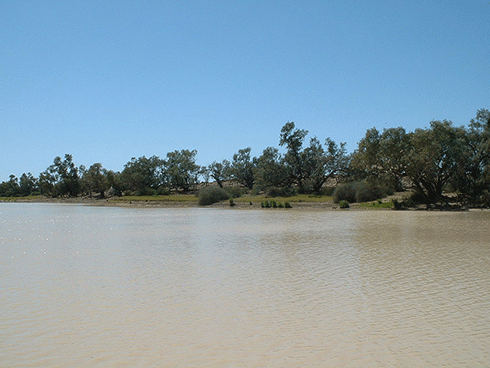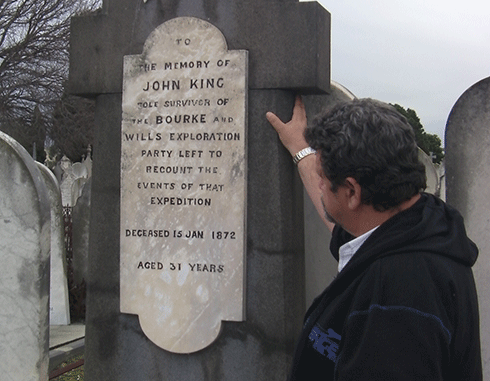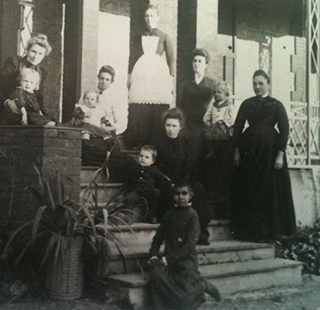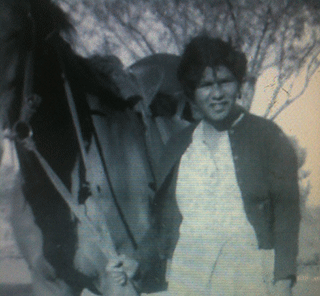
|
Published: 14 October 2013
Secrets of the Dig Tree
Aaron Paterson’s family tree would make for a captivating episode of Who Do You Think You Are. According to the family’s oral history, Aaron’s great-great-great-great grandfather was Irishman, John King – the only survivor from Burke and Wills’ fateful expedition to the Gulf of Carpentaria in 1860-61. Aaron’s great-great-great-great grandmother, Turinyi, was a girl from the local Yandruwandha tribe.
The Yandruwandha had looked after John King following the deaths of his superiors, Robert O’Hara Burke and William John Wills, by the banks of the Cooper Creek in South Australia in June 1861.
‘Yellow Alice’ – the half-caste daughter born to Turinyi (and probably unknown to King) months after King's rescue – was, until recently, a forgotten footnote to the narrative that’s grown up around the Burke and Wills expedition.
But in a recent book, The Aboriginal Story of Burke and Wills: forgotten narratives , historians explore the role Aboriginal people played – or were prevented from playing – in this well-trodden chapter of European Australian history.
In the book’s introduction, Aaron writes that in 1861, his ancestors were puzzled by the three kurrani (mad) white men – left behind by the main expedition, which had returned south – wandering up and down the Cooper Creek ‘like ghosts’. They were lost, hungry and thirsty; yet surrounded by plenty.
The Yandruwandha had honed their understanding of local ecology over millennia – they knew where and how to find food. And, surrounded by ancestral spirits hidden in the animals and plants around them, they never felt lonely.
Had the explorers invested more effort in trying to communicate and understand the ways of the Aboriginal people whose lands they’d entered, says Aaron, the outcome of the Burke and Wills’ expedition might have been very different.
Take the moment expeditioner William Brahe began carving the letters ‘DIG’ on the famous Dig Tree at Cooper Creek in 1861. Brahe’s intention was to leave a message to dig up the food and other stores buried at the base of the tree for the small group returning from the Gulf of Carpentaria, who were weeks overdue.
But to the Yandruwandha, it was an act of desecration. Brahe did not realise that, for the local people, the kulpuru or coolibah tree he’d hacked into was the home of spirit ancestors.
Then there was the time Burke became annoyed by a group of Yandruwandha gesturing to the three expeditioners to join them in what he assumed to be a ‘dance’.
‘In fact, those blackfellas were trying to communicate,’ says Aaron. When Burke fired a shot over the heads of the beckoning locals, they were dismayed. For the Yandruwandha, it was yet another insult from the group of strangers who’d entered their country unannounced and either ignored or exploited the goodwill of the local people.
‘This is why the “Welcome to Country” ceremony is still very important to Aboriginal people today,’ said Aaron. ‘You have to announce who you are, where you’re from, why you’re here, to the local people.
‘We Yandruwandha people are encouraged to do so when visiting our country to announce our arrival to the ngapitja (old spirits) to ensure a happy, safe and harmonious time on country.’

|
|
Cooper Creek near the Dig Tree: in 1861, local people were thriving on freshwater fish and mussels, along with plants and animals from the surrounding bush. Credit:
Peterdownunder/Wikimedia Commons
|
After Burke and Wills died, leaving King to fend for himself, the Yandruwandha took pity on the man who’d been treated like a slave by the two white officers.
‘He was carried by our people, they cared for him,’ says Aaron. ‘They knew he would not survive on his own.’
King was fortunate, as the diet he and the other two white men had adopted during those final months along the Cooper was later found to be toxic. They had seen Aboriginal women collecting and grinding ‘nardoo’ (ngardu), the ground sporocarps (similar to seed cases) of a local water-fern (Marsilea drummondii), which the women mixed with water and cooked like damper.
However, the men had not learned the correct way to process and cook nardoo, with the result they probably developed beri-beri through ingesting a plant compound that blocks vitamin B1 absorption in the body.
Aaron says King’s eventual rescue was another act of goodwill facilitated by the Yandruwandha, who took great pains to lead the rescue party to the by-now unrecognisable white man at Kuyapidri (now known as Queerbiddie) waterhole, regarded as the place ‘where all fish originated’.
Aaron is also keen to respond to historical criticism of the Yandruwandha for not burying the bodies of Burke and Wills after they came across them.
‘When King found Wills dead in his gunya or walpa, he noted that the natives had taken Wills’ clothes. But the truth is the Yandruwandha removed his loose clothing, removed some boughs from the gunyah Wills was lying in, and laid them across the body as a mark of respect.
‘Traditional Yandruwandha burials involved laying boughs across the grave. There was no theft of Wills' clothes and no natives were seen wearing any white man’s clothes by Howitt's relief expedition.’
King’s legacy was to live on among the Yandruwandha, in the form of the daughter born at Cooper Creek after his return to Melbourne (Aaron’s lineage can be found here).

|
|
Aaron Paterson visiting John King’s grave at the Melbourne General Cemetery, 2013. Credit:
courtesy of Aaron Paterson
|
Even today, away from his job at as a Court Support Officer for Aboriginal and Torres Strait Islander Legal Service (Qld) Ltd, Aaron can camp at Cooper Creek and feel at home, living off the land, just like his ancestors – an experience he recounts in the introduction to The Aboriginal Story of Burke and Wills.
‘I grab a stick and walk to the previous night’s fire and move the ashes around, then place dry leaves and coolabah seeds on the hot coals and blow them to life by fanning them with a sheet of bark. My store of green leaves is close by in readiness for the first sting of a koonti (mosquito) – the smoke will be my repellent tonight should I require it.
‘I get the fish I have gutted ready, then place them in the coals to one side to bake them. Kapi (catfish), ngampurru (yellowbelly), tharuwitji (bony bream), and some mussels pulled out of the mud in the water at the edge of Inimingka waterhole...in the desert paradise we Yandruwandha people call Kinipapa and the rest of the world calls “Cooper Creek”.’
While Aaron is proud of his Yandruwandha heritage and connection to country, he is also conflicted about the fate of John King, who died in 1872 at the age of 31, never having recovered his health. During a recent trip to Melbourne, Aaron had the opportunity to visit King’s grave and ‘talk to him’ for the first time.
‘The Yandruwandha people of old lived their lives according to a system of rules, some simple and some complex,’ says Aaron. ‘The basic rule was “respect/protect”.
‘It would not have occurred to these strangers on Yandruwandha traditional lands and waters that they were breaching a series of customary protocols. Some were simple ones, such as announcing their arrival at a distance, waiting for an invitation to enter camp and waiting for a spot to be picked out where they could camp. If they had followed these, no rules could have been broken and a strong level of trust would have been developed...it is surprising even today to think that our old people did not attack Burke’s party.
‘Perhaps one day, the Yandruwandha story, if more widely known, may show other Australians, whether grassroots or scholars, that a simple sit down and talk around a warm fire and sharing food opens understanding and appreciation of other people’s points of view.’
This story is dedicated to Aaron’s late younger sister, Amanda Jane May Paterson-Rivers, who was born in Brisbane 3 May 1975 and died on Magnetic Island 1 July 2013. Amanda was a proud young Yandruwandha woman, who was fascinated by the women’s involvement in the Burke, Wills and King story. She adored her maternal grandmother Edna ‘Saucy’ Kerwin.
CSIRO values the contribution Indigenous knowledge adds to Australia’s scientific and social research, and is committed to carrying out research that contributes to the challenges and aspirations of Indigenous communities, and encouraging more Indigenous people to work with the organisation.
|
Annie King – known as ‘Yellow Alice’ to the local white community – was Aaron’s great-great-great grandmother, and the first half-caste to be born in the Yandruwandha tribe. Annie’s mother Turinyi was the daughter of Carrawaw, who helped look after King before his rescue in 1861. |
‘The old people called Annie padlaka pirtipirti, the word they used for all white people,’ says Aaron. ‘It means “red body” – a lot of the early white people the Yandruwandha saw were sunburned. |
‘At first, she was a bit of an outcast. Some Yandruwandha from other clans thought she was evil, so she had to be protected by my great-great-great-great grandfather’s family group.’ |
Indeed, it is said that Carrawaw, who had two sons, regarded King as her third. So strong was her affection for him that when he was rescued, Carrawaw 'screamed and bawled' at John King's departure, even cutting her breasts with a sharpened mussel shell – an act of mourning usually associated with the actual death of a close relative. |
Annie King had a daughter, Cora, in 1874 – when she was only 13 years old. According to Aaron, it was the custom for girls to be promised to husbands young, with the result that ‘children gave birth to children’. Annie had a second child, Peter, known as ‘King Peter of Nappamerrie’. |
Cora King had two children with Robert Parker, a white stockman working at Nappamerrie homestead. They were ‘Yellow Bob’ Parker, referring to his skin colour as a half-caste or pubili, and Nelly. Sadly Cora Parker died two weeks after she fell into a camp fire at Nappamerrie station in 1932. |
In 1923, Cora’s daughter Nelly married a Yandruwandha half-caste Aboriginal man from Innamincka, Benny ‘Mangili’ Kerwin. They had four children – Lenny, Edna (Aaron’s maternal grandmother or kanyini), Benny Jnr and Jack. Edna had twelve children, the first being Gloria Jean Kerwin (‘named after Hollywood actress Gloria Swanson, as Gloria was born 1942 with a birthmark on her chin like the actress’, according to Aaron). |
In 1960, Gloria married a stockman, Rodney Charles Paterson, ‘a Wynnum boy from Brisbane’, and they had three children, Anita, Aaron and Donald. Gloria later had a fourth child, Amanda, whose father was Maori, from Kaitaia on New Zealand's north island. |





